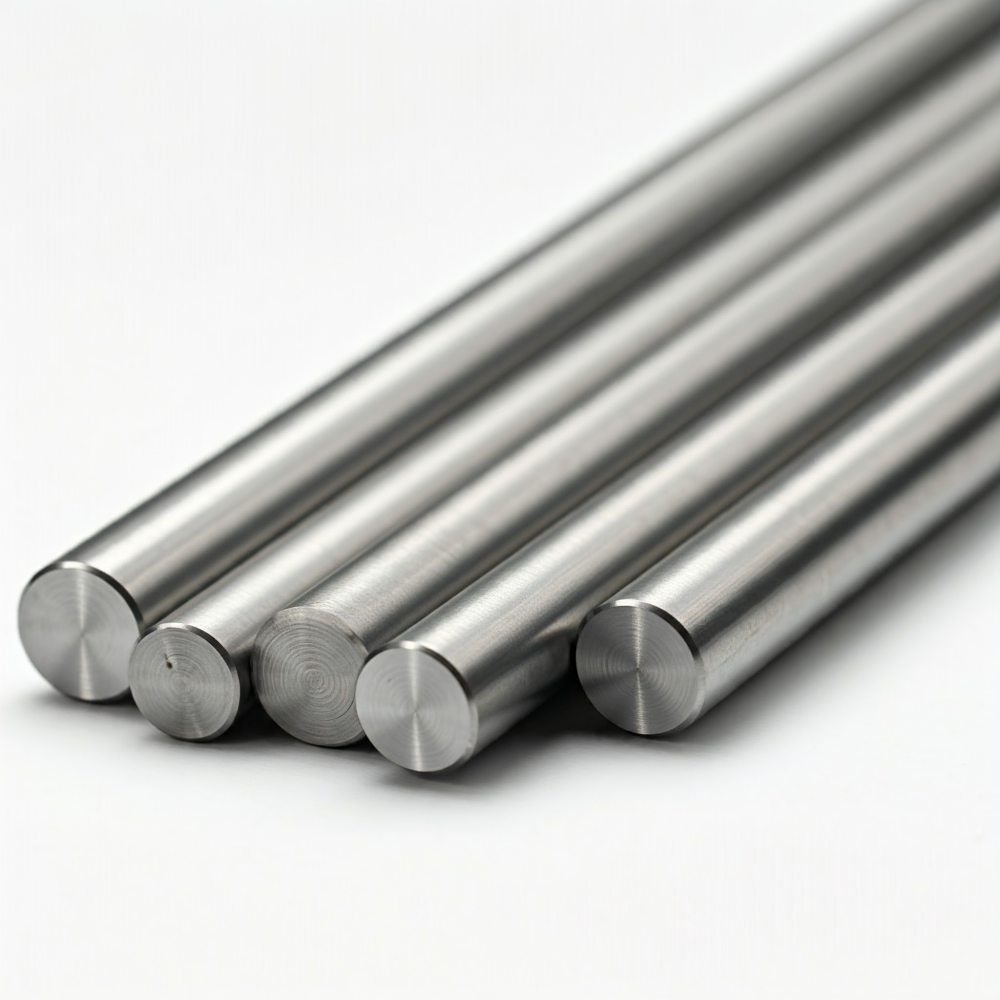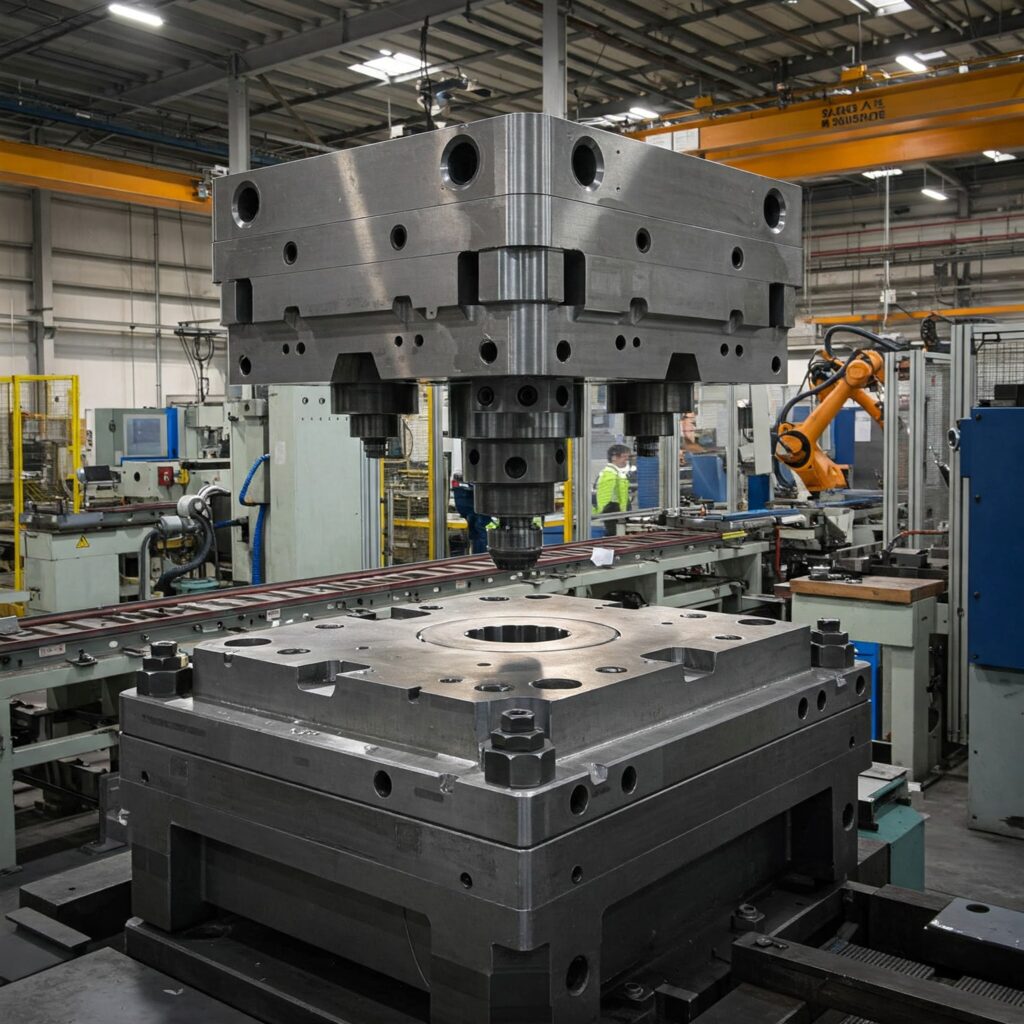Stal narzędziowa D2 I Stal narzędziowa A2 są obydwa stale narzędziowe do obróbki na zimno i nadają się do stosowania w warunkach poniżej 200°C (390°F). W przypadku stosowania w warunkach wysokiej temperatury mogą one ulec wyżarzanie lub pękanie na skutek szoku termicznego, powodujące uszkodzenie materiału.
W systemie klasyfikacji AISI A2 należy do grupy „stopów utwardzanych na powietrzu, średniostopowych” (Grupa A), natomiast D2 należy do grupy „wysokowęglowych, wysokochromowych” (Grupa D).
1. Skład chemiczny i mikrostruktura
Stal D2 to stal wysokowęglowa i wysokochromowa. Z perspektywy mikrostrukturalnej te elementy tworzą dużą ilość węglików, szczególnie węglików M7C3 bogatych w chrom. To właśnie te węgliki nadają stali D2 jej wysoką nosić odporność i twardość. Po odpowiednim obróbka cieplnaobjętość frakcji nierozpuszczonych węglików w mikrostrukturze D2 wynosi około 13% i jest znacznie wyższa niż w przypadku A2.
Zawartość chromu około 5% w stali A2 zapewnia jej odporność na zmiękczanie w wysokich temperaturach. A2 wykazuje dobrą odporność na zużycie dzięki swojej mikrostrukturze, która charakteryzuje się równomiernie rozłożonymi strukturami martenzytu wysokowęglowego i węglikami. Chociaż A2 zawiera węgliki stopowe, jego wielkość ziarna jest mniejsza niż stali serii D2.
Odniesienia: 1. JR Davis, Metals Handbook Desk Edition, wydanie 2, Międzynarodowy Komitet Podręczników ASM. 2. Doktor Rafael A. Mesquita, STALE NARZĘDZIOWE Właściwości i wydajność, Wydawnictwo CRC Press.
2. Twardość i odporność na zużycie
Zarówno stal narzędziowa D2, jak i stal narzędziowa A2 wykazują doskonałą odporność na zużycie, przy czym D2 oferuje wyższą odporność na zużycie niż A2. Powody tego są wyjaśnione w poprzednim akapicie z perspektywy składu i mikrostruktury. Na podstawie naszego doświadczenia odporność na zużycie D2 można poprawić za pomocą 30% do 40% w porównaniu z A2. Po przejściu podwójnego ruszenie Dzięki procesowi obróbki cieplnej stal D2 może osiągnąć twardość Rockwella na poziomie 58 HRC, co skutkuje 25%–30% poprawą odporności na zużycie w porównaniu z tradycyjnym procesem odpuszczania.
3. Wytrzymałość
Stal narzędziowa A2 charakteryzuje się wysoką wytrzymałość. W porównaniu z D2, stal A2 ma większą wytrzymałość, podczas gdy D2 jest bardziej krucha. Niższa wytrzymałość stali D2 wynika z jej wysokiej zawartości węgla, a to właśnie te węgliki nadają stali D2 doskonałą odporność na zużycie. Dlatego odporność na zużycie i wytrzymałość nie mogą być osiągnięte jednocześnie.
4. Hartowalność i obróbka cieplna
4.1 Utwardzanie i odkształcanie w powietrzu
A2 i D2 to gatunki stali, w których wykorzystuje się głównie powietrze gaszenie. Hartowanie w powietrzu odnosi się do procesu chłodzenia od temperatury austenityzacji do temperatury pokojowej w celu osiągnięcia całkowitego utwardzenia. Jego zalety obejmują minimalne odkształcenie materiału i niskie ryzyko pękania. W porównaniu do stali hartowanej w oleju lub wodzie, A2 i D2 wykazują mniejsze odkształcenie, właśnie dlatego, że zmiana temperatury podczas hartowania w powietrzu jest bardzo powolna.
Zarówno A2, jak i D2 wykazują doskonałą stabilność wymiarową podczas hartowania. Po hartowaniu powietrzem w odpowiedniej temperaturze hartowania, A2 rozszerza się o około 0,001 cala na cal. D2 osiąga tzw. „zmianę zero-wymiarową” poprzez precyzyjną kontrolę równowagi między austenitem i martenzytem poprzez wielokrotne cykle odpuszczania. Chcielibyśmy podkreślić, że D2 zachowuje do 20% swojej struktury austenitycznej po hartowaniu. Jeśli nie zostanie odpowiednio poddany obróbce poprzez późniejsze hartowanie lub obróbkę w niskiej temperaturze, może to prowadzić do niestabilności wymiarowej.
4.2 Hartowanie
Pojedynczy cykl odpuszczania jest zazwyczaj wystarczający dla A2, podczas gdy D2 wymaga złożonego cyklu odpuszczania. Pojedyncza temperatura odpuszczania dla A2 wynosi 400°F (205°C). Jeśli wymagany jest drugi cykl odpuszczania, temperatura jest nieznacznie obniżana do 375°F (190°C). Celem drugiego cyklu odpuszczania dla A2 jest udoskonalenie struktury ziarna. Po drugim cyklu odpuszczania A2 jest szczególnie korzystne dla części o złożonych przekrojach poprzecznych, ostrych kątach lub części wymagających dłuższej żywotności narzędzia i lepszej wytrzymałości.
W przypadku D2 pojedyncza temperatura odpuszczania wynosi 400°F (205°C), co pozwala uzyskać twardość około 62 HRC. Jednak bardziej zalecaną i powszechną metodą dla D2 jest podwójne odpuszczanie. Pierwsza temperatura odpuszczania w procesie podwójnego odpuszczania wynosi 960°F (515°C), po której następuje drugie odpuszczanie w temperaturze 900°F (480°C), przy czym każde odpuszczanie trwa 2 godziny na cal przekroju poprzecznego. Ten proces podwójnego odpuszczania w wysokiej temperaturze udoskonala strukturę ziarna, znacznie zwiększając odporność na zużycie i odprężanie. W przypadku D2, wysokowęglowej, wysokochromowej stali hartowanej na powietrzu, zdecydowanie zalecamy podwójne odpuszczanie, a w niektórych przypadkach nawet potrójne odpuszczanie, aby promować przemianę austenitu resztkowego w martenzyt.
5. Obróbka skrawaniem i szlifowalność
A2 jest łatwy do obróbki i szlifowania, podczas gdy D2 jest trudny do obróbki i szlifowania. Jeśli obróbka i szlifowanie stali W1 jest ustawione na 100, to A2 ma 60 punktów, a D2 45. Powyższy tekst wyjaśnia, dlaczego D2 jest trudny do obróbki i szlifowania z perspektywy składu i mikrostruktury. To kolejny przykład dwóch stron tej samej monety.
6. Typowe zastosowania
Zastosowania stali narzędziowej D2: D2 jest szeroko stosowany do umiera długoterminowo. Wyjątkowa odporność na zużycie sprawia, że idealnie nadaje się do:
- Wykrojniki, formy i matryce do głębokiego tłoczenia: Szczególnie nadaje się do długich serii produkcyjnych, cięcia laminatów i walcowania gwintów.
- Dziurkacze i matryce: Ze względu na wysoką odporność na zużycie.
- Noże tnące i rozcinające: Do produkcji na dużą skalę z materiałów cienkich i średniej grubości.
- Przyrządy pomiarowe, narzędzia do polerowania, rolki, formy do cegieł: Gdzie najważniejsza jest maksymalna odporność na ścieranie i stabilność wymiarowa.
- Cięcie na gorąco odkuwek: Chociaż D2 jest głównie przeznaczony do obróbki na zimno, można go również stosować do obróbki na gorąco, gdy wytrzymałość nie jest tak istotna.
Zastosowania stali narzędziowej A2: A2 to wszechstronny wybór ogólnego przeznaczenia, ceniony za równowagę odporności na ścieranie i wytrzymałość, a także minimalne odkształcenia podczas obróbki cieplnej. Typowe zastosowania obejmują:
- Wykrojniki i stemple uniwersalne: Do wykrawania, formowania i ciągnienia, szczególnie tam, gdzie wymagana jest dobra odporność na ścieranie i zwiększona wytrzymałość.
- Główne piasty i formy: Szczególnie w przypadku małych form, gdzie ważna jest dobra odporność na zużycie i stabilność wymiarowa.
- Ostrza nożyc: Do ścinania na zimno, zapewniają dobrą odporność na zużycie.
- Piły: Jest to materiał uniwersalny do wielu zastosowań w piłach.
- Matryce stałe: Często preferowany w stosunku do D2 lub D3 w przypadku solidnych stempli i matryc, w przypadku których nie jest możliwe intensywne szlifowanie, ponieważ A2 zapewnia lepszą równowagę między wytrzymałością i hartownością w przypadku większych przekrojów.
7. Rozważania dotyczące wyboru strategicznego
Wybierając pomiędzy D2 i A2, weź pod uwagę następujące kwestie:
- Wielkość produkcji i ścieralność:D2 nadaje się do bardzo długich cykli produkcyjnych lub materiałów obrabianych o wysokiej ścieralności, natomiast A2 nadaje się do średnich cykli produkcyjnych lub materiałów o niskiej ścieralności.
- Obciążenie udarowe i ryzyko odprysków: Jeśli chodzi o materiały używane do produkcji noży, stal A2 ma większą wytrzymałość i ciągliwość, co czyni ją bardziej odpowiednią do noży. Z drugiej strony stal D2 jest zbyt krucha i podatna na odpryskiwanie.
- Koszty wykonania: Materiał D2 jest trudniejszy w obróbce i szlifowaniu, dlatego materiał A2 ma niższe koszty przetwarzania.
Podsumowując, jeśli potrzebujesz materiału o lepszej odporności na zużycie, D2 jest lepszym wyborem. Zaleta A2 leży w jego lepszej wytrzymałości i ciągliwości. Zaleta w jednej sytuacji może stać się wadą w innej, dlatego ważne jest, aby w pełni zrozumieć cechy obu materiałów, aby dokonać właściwego wyboru.
Chcesz zaopatrzyć się w stal narzędziową D2 o wysokiej wydajności?
Mając ponad 20 lat doświadczenia w kuciu, Aobo Steel jest Twoim zaufanym partnerem w zakresie najwyższej jakości stali narzędziowej D2. Dostarczamy materiały, które spełniają Twoje dokładne wymagania dotyczące wysokiej odporności na zużycie i trwałości. Zaufaj naszym ekspertom, aby wykonać zadanie właściwie.
Omówmy potrzeby Twojego projektu.
Wypełnij poniższy formularz, aby uzyskać konkurencyjną wycenę i fachową konsultację od naszych specjalistów. Szybko odpowiemy, aby omówić Twoje wymagania.


